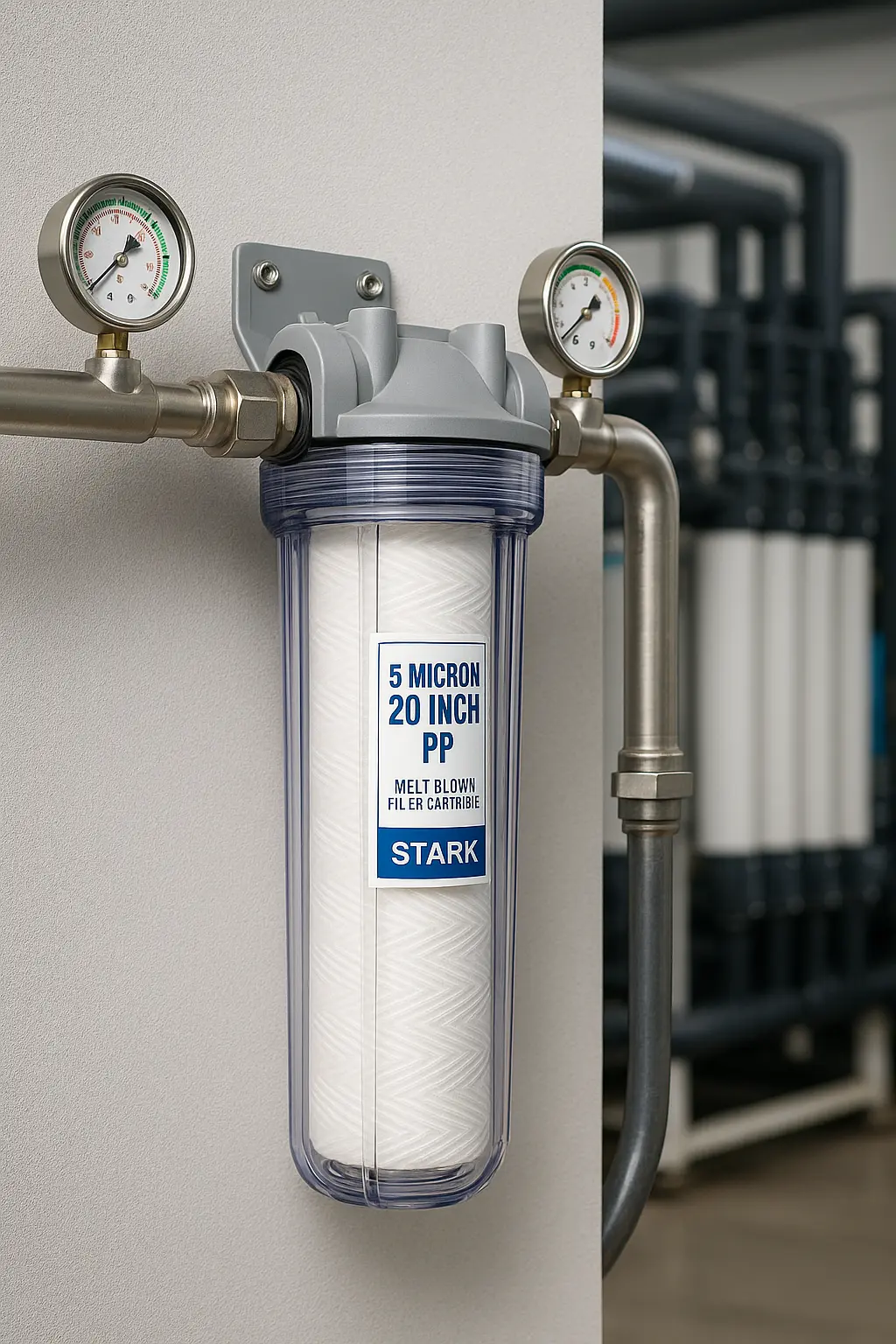If you run sediment pretreatment, you’ve likely asked: how long will a 5 micron 20 inch PP filter last, and what’s the safest way to decide the replacement time? This guide gives you actionable thresholds using pressure drop (ΔP), water quality trends, and scenario-based timelines you can apply immediately.
Quick Answer: 3 Signals That Trigger Replacement
- ΔP (pressure drop): Replace around 0.10 MPa (≈15 psi). Above this, pump energy rises sharply and bypass risk increases.
- Filtrate quality: Rising turbidity/particle count or unusual pressure drop across downstream carbon/RO indicates breakthrough.
- Time backstop: Even if ΔP is low, change the cartridge every 1–3 months depending on load and feed quality.
Use ΔP and filtrate quality as the main controls; use time as a conservative backstop.
Why Does the 5 micron 20 inch pp filter “Tighten” Over Time?
Gradient-depth melt-blown structure
The cartridge uses a graded density design—open fibers outside and tighter fibers toward the core. Larger particles are intercepted first, finer ones later, which increases dirt-holding capacity and keeps initial ΔP low.
Fouling mechanisms
Seasonal turbidity, colloids, iron/manganese, and load spikes progressively block pores, so ΔP climbs over time. Melt-blown PP is not designed for backwashing; cleaning attempts can damage the fiber pathways and risk breakthrough.
Where 5 μm fits in a train
A common staging is 20 μm → 5 μm → carbon/RO. The 5 μm stage is the “general purpose” guard that balances capture efficiency and reasonable ΔP.
How to Judge Replacement Time (Step by Step)
1) Monitor ΔP (priority signal)
- Install gauges on housing inlet/outlet. Record weekly:
ΔP = P_in − P_out. - Typical new-cartridge ΔP at design flow: 0.02–0.05 MPa.
- Replacement threshold: 0.10 MPa (≈15 psi) or when the growth rate accelerates.
2) Watch filtrate quality and downstream behavior
- Rising turbidity/SDI or visible clarity drop.
- Higher ΔP across carbon/softener/RO compared to baseline suggests upstream breakthrough.
3) Time-based backstop
Set a conservative calendar limit and refine it with your ΔP data:
- Good municipal feed / light duty: 8–12 weeks
- Average duty (typical RO pretreatment): 4–8 weeks
- Poor feed / high load (well/surface water peaks): 2–4 weeks
Worked Example: Estimating Cartridge Life From ΔP Trend
Given: 5 micron 20 inch PP filter, design flow ~14 L/min; new ΔP ΔP₀ = 0.03 MPa. Weekly ΔP increase (site data): k = 0.003 MPa/week. Allowed ΔP ΔP* = 0.10 MPa.
Usable ΔP margin = ΔP* − ΔP₀ = 0.07 MPa → Estimated life ≈ 0.07 / 0.003 = ~23 weeks.
注: k depends heavily on season and solids loading. If sudden load spikes occur, obey the threshold, not the estimate.
経験則だ: Life (weeks) ≈ (ΔP* − ΔP0) / k
Recommended Replacement Intervals by Scenario
| Scenario | Typical Flow | New ΔP | Replace at ΔP | Suggested Interval | 備考 |
|---|---|---|---|---|---|
| Residential / light commercial POE | 8–12 L/min | 0.02–0.04 MPa | 0.10 MPa | 8–12 weeks | Use calendar backstop; refine with gauges |
| Industrial RO pretreatment | 12–16 L/min | 0.03–0.05 MPa | 0.10 MPa | 4–8 weeks | Track RO SDI and ΔP curves |
| Well/surface water (muddy season) | 10–16 L/min | 0.04–0.06 MPa | 0.10 MPa | 2–4 weeks | Add sand/UF ahead to reduce load |
| Food & beverage batch prep | Process-specific | - | 0.10 MPa | Per batch or ΔP | Change with batch turnover |
Choosing the Right 5 Micron 20″ PP Filter (to Avoid Over-Frequent Changes)

Key specifications
- Size: 2.5″ × 20″ (check OD/ID tolerances), double open end (DOE)
- Seals: EPDM standard; FKM (Viton) optional to match chemical conditions
- Design flow & initial ΔP: confirm at your operating flow/temperature
- Gradient-depth construction: higher dirt-holding capacity and smoother ΔP curve
Staging & load management
Use 20 μm → 5 μm → carbon/RO. For heavy solids, add a mesh/sand/UF step to protect cartridges.
よくある落とし穴
- Jumping straight to 1 μm for all loads → early clogging and higher energy.
- Trying to backwash/reuse melt-blown PP → fiber damage and breakthrough risk.
Replacement Steps & Safety Notes
- Shut inlet/outlet valves and depressurize to 0.
- Open housing, remove the cartridge. Clean the seat and inspect the O-ring.
- Insert new cartridge (correct orientation), lightly lube seal with food-grade grease.
- Close housing, open valves slowly to vent air, check for leaks.
- Log date, flow, ΔP, and any water quality notes for trend analysis.
- Dispose of the spent cartridge per local regulations (industrial sites: follow waste policy).
Weekly Check Template (Columns to Track)
Date | Flow | P_in | P_out | ΔP | Turbidity/SDI | Notes — keeping this simple log quickly reveals your optimal interval.
Frequently Asked Questions
Should I pick 1 μm, 5 μm, or 10/20 μm?
For general pretreatment, 20 μm → 5 μm is a dependable combo. 1 μm is for very low particle tolerance but clogs faster. Choose based on feed solids and downstream needs.
Can a 5 micron 20 inch PP filter be backwashed or reused?
Not recommended. Melt-blown polypropylene is not backwashable; cleaning can damage the fiber structure and lead to particle breakthrough.
Is the material safe for drinking water?
PP media is commonly used for potable-water pretreatment. Compliance depends on the complete system (housing, seals, local regulations); verify to your jurisdiction and project requirements.
How does it work with carbon and RO?
As a sediment barrier upstream of carbon/RO, it reduces particulate load, stabilizes SDI, and typically extends downstream element life.
Get Pricing or a Sample
Need a reliable supply of 5 micron 20 inch PP filter cartridges? Contact STARK for quotes, private label, and documentation.
Technical reviewer: STARK Water Editorial | Last updated: 2025-09-02
All values are typical and configurable. Replacement intervals depend on actual feed quality and load; always verify with your site data and regulations.

